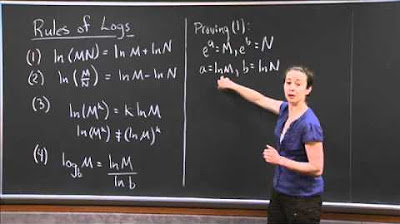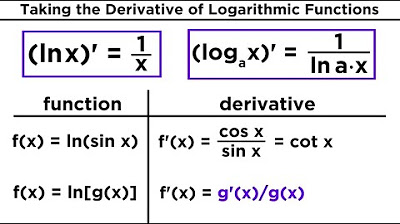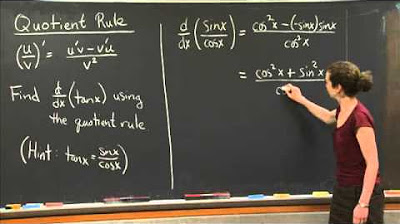Log and Exponent Derivatives | MIT 18.01SC Single Variable Calculus, Fall 2010
TLDRIn this educational recitation, Professor Christine Breiner guides students through the process of finding derivatives of three different functions involving exponential and logarithmic properties. She emphasizes common mistakes, such as misapplying the power rule to 'pi to the x', and demonstrates the chain rule for functions like the natural log of cosine(x), leading to the intriguing result of negative tangent(x). The third example showcases the simplification of the derivative of the natural log of e to the power of x squared, highlighting the importance of understanding logarithmic identities and the exponential function's derivative.
Takeaways
- 📚 The session focuses on practicing the use of derivative tools for exponential and logarithmic functions.
- 🔑 The first function involves a common mistake where 'pi to the x' is not treated as a power of x but as an exponential function with base pi.
- 📝 The derivative of 'x to the pi' is pi times x to the power of (pi - 1), not x times pi to the power of (x - 1).
- 🧩 The second function, 'g(x) = natural log of cosine of x', requires the chain rule and results in the derivative being negative tangent of x.
- 🔍 The derivative of 'natural log of cosine x' is an interesting example showing that a non-trigonometric function can lead to a trigonometric derivative.
- 📉 The third function 'h(x) = natural log of e to the x squared' is initially tackled using the slow method involving the chain rule with three parts.
- 🚀 The fast way to find the derivative of the third function is recognizing that 'natural log of e to the x squared' simplifies to x squared, leading to a derivative of 2x.
- 🤓 The importance of understanding logarithms and exponentials is highlighted, especially in recognizing the simplification of complex expressions.
- 📌 The script emphasizes the value of stepping back to see if a problem can be simplified before applying the derivative rules.
- 📈 The session provides a clear demonstration of applying the derivative rules to functions with exponential and logarithmic components.
- 📚 The transcript serves as a teaching tool, illustrating common mistakes and strategies for correctly finding derivatives of complex functions.
Q & A
What is the main topic of the recitation session?
-The main topic of the recitation session is practicing the use of tools for taking derivatives of exponential and logarithmic functions.
How many example functions are provided in the script for finding derivatives?
-Three example functions are provided in the script for the purpose of finding their derivatives.
What is the first function given in the script, and what is a common mistake made when trying to find its derivative?
-The first function is f(x) = x^π + π^x. A common mistake is to incorrectly apply the power rule to π^x, treating it as a power of x instead of an exponential function with base π.
What is the correct derivative of x^π in the first example function?
-The correct derivative of x^π is πx^(π-1), applying the power rule for the term x^π.
What is the derivative of π^x in the first example function, and why is it not a simple power rule application?
-The derivative of π^x is π^x * ln(π), using the exponential function derivative rule. It is not a simple power rule because π^x is an exponential function with base π, not a power of x.
What is the second function given in the script, and what rule is required to find its derivative?
-The second function is g(x) = ln(cos(x)). The chain rule is required to find its derivative because it involves a function of a function.
What is the derivative of the second function, g(x), and how does it relate to the tangent function?
-The derivative of g(x) is -sin(x)/cos(x), which simplifies to -tan(x). This shows that the negative natural log of the cosine of x is a function whose derivative is the tangent of x.
What is the third function given in the script, and what simplification can be made before finding its derivative?
-The third function is h(x) = ln(e^(x^2)). The simplification that can be made is recognizing that ln(e^(x^2)) is equal to x^2 because the natural log and the exponential function with base e are inverse functions.
What is the fast way to find the derivative of the third function, h(x), without using the chain rule?
-The fast way is to use the property of inverse functions to simplify ln(e^(x^2)) to x^2, and then directly apply the power rule to find the derivative, which is 2x.
What is the slow way to find the derivative of the third function, and why is it less efficient?
-The slow way involves using the chain rule multiple times to differentiate the composition of functions. It is less efficient because it requires more steps and calculations compared to the simplification method.
Why is it beneficial to recognize the simplification in the third function before applying the derivative rules?
-Recognizing the simplification in the third function allows for a quicker and more straightforward calculation of the derivative, reducing the potential for errors and making the problem-solving process more efficient.
Outlines
📚 Derivative Practice with Exponential and Logarithmic Functions
Christine Breiner introduces a recitation session focused on practicing the differentiation of exponential and logarithmic functions. She presents three functions for students to differentiate: f(x) = x^π + π^x, g(x) = ln(cos(x)), and h(x) = ln(e^(x^2)). After giving students time to work on the problems, she begins by explaining the common mistake made with the first function, emphasizing that π^x is an exponential function, not a power of x, and its derivative is ln(π)π^x. She then moves on to the second function, which requires the chain rule, and shows that the derivative of ln(cos(x)) is -sin(x)/cos(x) or -tan(x), highlighting an interesting property where a non-trigonometric function's derivative can be trigonometric.
🔍 Simplifying Complex Derivatives with Logarithmic and Exponential Functions
The second paragraph delves into the differentiation of the third function, h(x) = ln(e^(x^2)), using both the slow and fast methods. The slow method involves applying the chain rule multiple times, leading to a simplification that results in 2x. The fast method showcases a clever insight: recognizing that ln(e^(x^2)) simplifies to x^2 due to the properties of logarithms and exponentials, thus directly leading to the derivative of 2x. This approach emphasizes the importance of understanding the underlying mathematical principles to simplify complex problems and arrive at solutions more efficiently.
Mindmap
Keywords
💡Derivative
💡Exponential Functions
💡Logarithmic Functions
💡Chain Rule
💡Natural Logarithm
💡Trigonometric Functions
💡Power Rule
💡Common Mistake
💡Inverse Functions
💡Simplification
💡Composition of Functions
Highlights
Introduction to practicing derivatives of exponential and logarithmic functions.
Three example functions provided to find derivatives.
Common mistake highlighted in taking derivative of x^pi.
Clarification that pi^x is an exponential function, not a power of x.
Derivative of x^pi is pi(x^(pi-1)).
Derivative of pi^x requires exponential function rule.
Derivative of pi^x is ln(pi) * pi^x.
Chain rule needed for derivative of ln(cos(x)).
Derivative of ln(cos(x)) is -sin(x)/cos(x), which simplifies to -tan(x).
Interesting insight that -ln(cos(x)) has a derivative of tan(x).
Derivative of ln(e^(x^2)) requires understanding of exponential and logarithmic functions.
Slow way to find derivative of ln(e^(x^2)) involves multiple applications of the chain rule.
Fast way to simplify ln(e^(x^2)) by recognizing it as x^2.
Derivative of x^2 is 2x, illustrating the power of simplification.
Importance of understanding logarithmic and exponential properties for problem-solving.
Final example demonstrates the value of recognizing simplifications in derivatives.
Transcripts
Browse More Related Video

Derivatives of Exponential Functions

Rules of Logs | MIT 18.01SC Single Variable Calculus, Fall 2010

Derivatives of Logarithmic and Exponential Functions

Derivatives of Log Functions

Logarithmic functions differentiation | Advanced derivatives | AP Calculus AB | Khan Academy

Quotient Rule | MIT 18.01SC Single Variable Calculus, Fall 2010
5.0 / 5 (0 votes)
Thanks for rating: